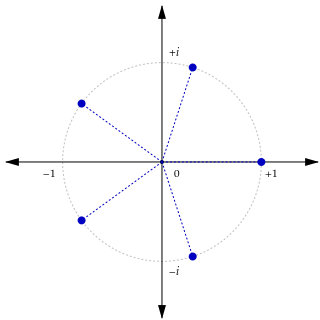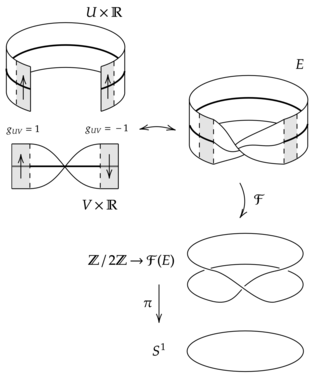Definition
The dual bundle of a vector bundle is the vector bundle whose fibers are the dual spaces to the fibers of .
Equivalently, can be defined as the Hom bundle that is, the vector bundle of morphisms from to the trivial line bundle
In mathematics, the dual bundle is an operation on vector bundles extending the operation of duality for vector spaces.
The dual bundle of a vector bundle is the vector bundle whose fibers are the dual spaces to the fibers of .
Equivalently, can be defined as the Hom bundle that is, the vector bundle of morphisms from to the trivial line bundle
Given a local trivialization of with transition functions a local trivialization of is given by the same open cover of with transition functions (the inverse of the transpose). The dual bundle is then constructed using the fiber bundle construction theorem. As particular cases:
If the base space is paracompact and Hausdorff then a real, finite-rank vector bundle and its dual are isomorphic as vector bundles. However, just as for vector spaces, there is no natural choice of isomorphism unless is equipped with an inner product.
This is not true in the case of complex vector bundles: for example, the tautological line bundle over the Riemann sphere is not isomorphic to its dual. The dual of a complex vector bundle is indeed isomorphic to the conjugate bundle but the choice of isomorphism is non-canonical unless is equipped with a hermitian product.
The Hom bundle of two vector bundles is canonically isomorphic to the tensor product bundle
Given a morphism of vector bundles over the same space, there is a morphism between their dual bundles (in the converse order), defined fibrewise as the transpose of each linear map Accordingly, the dual bundle operation defines a contravariant functor from the category of vector bundles and their morphisms to itself.
In mathematics, especially in category theory and homotopy theory, a groupoid generalises the notion of group in several equivalent ways. A groupoid can be seen as a:

In mathematics, an isomorphism is a structure-preserving mapping between two structures of the same type that can be reversed by an inverse mapping. Two mathematical structures are isomorphic if an isomorphism exists between them. The word isomorphism is derived from the Ancient Greek: ἴσοςisos "equal", and μορφήmorphe "form" or "shape".
In category theory, a branch of mathematics, a natural transformation provides a way of transforming one functor into another while respecting the internal structure of the categories involved. Hence, a natural transformation can be considered to be a "morphism of functors". Informally, the notion of a natural transformation states that a particular map between functors can be done consistently over an entire category.

In mathematics, a vector bundle is a topological construction that makes precise the idea of a family of vector spaces parameterized by another space : to every point of the space we associate a vector space in such a way that these vector spaces fit together to form another space of the same kind as , which is then called a vector bundle over .

In mathematics, and particularly topology, a fiber bundle is a space that is locally a product space, but globally may have a different topological structure. Specifically, the similarity between a space and a product space is defined using a continuous surjective map, that in small regions of behaves just like a projection from corresponding regions of to The map called the projection or submersion of the bundle, is regarded as part of the structure of the bundle. The space is known as the total space of the fiber bundle, as the base space, and the fiber.
In mathematics, in particular in algebraic topology, differential geometry and algebraic geometry, the Chern classes are characteristic classes associated with complex vector bundles. They have since found applications in physics, Calabi–Yau manifolds, string theory, Chern–Simons theory, knot theory, Gromov–Witten invariants, topological quantum field theory, the Chern theorem etc.
In mathematics, a principal bundle is a mathematical object that formalizes some of the essential features of the Cartesian product of a space with a group . In the same way as with the Cartesian product, a principal bundle is equipped with

In mathematics, a frame bundle is a principal fiber bundle F(E) associated to any vector bundle E. The fiber of F(E) over a point x is the set of all ordered bases, or frames, for Ex. The general linear group acts naturally on F(E) via a change of basis, giving the frame bundle the structure of a principal GL(k, R)-bundle.
In mathematics, the theory of fiber bundles with a structure group allows an operation of creating an associated bundle, in which the typical fiber of a bundle changes from to , which are both topological spaces with a group action of . For a fiber bundle F with structure group G, the transition functions of the fiber in an overlap of two coordinate systems Uα and Uβ are given as a G-valued function gαβ on Uα∩Uβ. One may then construct a fiber bundle F′ as a new fiber bundle having the same transition functions, but possibly a different fiber.
In mathematics, and especially differential geometry and gauge theory, a connection is a device that defines a notion of parallel transport on the bundle; that is, a way to "connect" or identify fibers over nearby points. A principal G-connection on a principal G-bundle P over a smooth manifold M is a particular type of connection which is compatible with the action of the group G.
In mathematics, especially in algebraic geometry and the theory of complex manifolds, coherent sheaves are a class of sheaves closely linked to the geometric properties of the underlying space. The definition of coherent sheaves is made with reference to a sheaf of rings that codifies this geometric information.
In mathematics, a gerbe is a construct in homological algebra and topology. Gerbes were introduced by Jean Giraud following ideas of Alexandre Grothendieck as a tool for non-commutative cohomology in degree 2. They can be seen as an analogue of fibre bundles where the fibre is the classifying stack of a group. Gerbes provide a convenient, if highly abstract, language for dealing with many types of deformation questions especially in modern algebraic geometry. In addition, special cases of gerbes have been used more recently in differential topology and differential geometry to give alternative descriptions to certain cohomology classes and additional structures attached to them.
In mathematics, in particular in algebraic topology and differential geometry, the Stiefel–Whitney classes are a set of topological invariants of a real vector bundle that describe the obstructions to constructing everywhere independent sets of sections of the vector bundle. Stiefel–Whitney classes are indexed from 0 to n, where n is the rank of the vector bundle. If the Stiefel–Whitney class of index i is nonzero, then there cannot exist everywhere linearly independent sections of the vector bundle. A nonzero nth Stiefel–Whitney class indicates that every section of the bundle must vanish at some point. A nonzero first Stiefel–Whitney class indicates that the vector bundle is not orientable. For example, the first Stiefel–Whitney class of the Möbius strip, as a line bundle over the circle, is not zero, whereas the first Stiefel–Whitney class of the trivial line bundle over the circle, , is zero.

In mathematics, specifically in algebraic geometry, the Grothendieck–Riemann–Roch theorem is a far-reaching result on coherent cohomology. It is a generalisation of the Hirzebruch–Riemann–Roch theorem, about complex manifolds, which is itself a generalisation of the classical Riemann–Roch theorem for line bundles on compact Riemann surfaces.
In mathematics, a complex vector bundle is a vector bundle whose fibers are complex vector spaces.

In mathematics, a complex torus is a particular kind of complex manifold M whose underlying smooth manifold is a torus in the usual sense. Here N must be the even number 2n, where n is the complex dimension of M.
In mathematics—more specifically, in differential geometry—the musical isomorphism is an isomorphism between the tangent bundle and the cotangent bundle of a pseudo-Riemannian manifold induced by its metric tensor. There are similar isomorphisms on symplectic manifolds. The term musical refers to the use of the symbols (flat) and (sharp).
This is a glossary of algebraic geometry.
In mathematics, an affine bundle is a fiber bundle whose typical fiber, fibers, trivialization morphisms and transition functions are affine.
In algebraic geometry, a prestackF over a category C equipped with some Grothendieck topology is a category together with a functor p: F → C satisfying a certain lifting condition and such that locally isomorphic objects are isomorphic. A stack is a prestack with effective descents, meaning local objects may be patched together to become a global object.